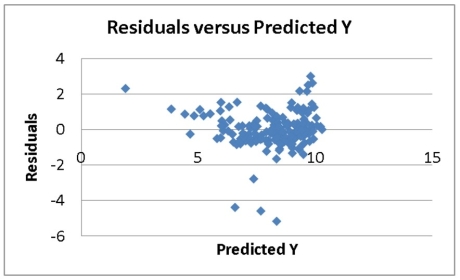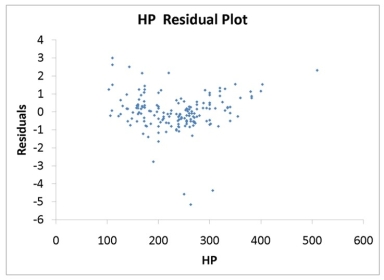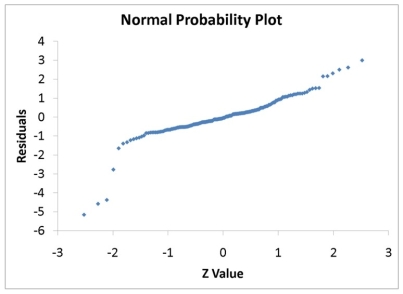TABLE 13-16
What are the factors that determine the acceleration time (in sec.) from 0 to 60 miles per hour of a car? Data on the following variables for 171 different vehicle models were collected:
Accel Time: Acceleration time in sec.
Cargo Vol: Cargo volume in cu. ft.
HP: Horsepower
MPG: Miles per gallon
SUV: 1 if the vehicle model is an SUV with Coupe as the base when SUV and Sedan are both 0
Sedan: 1 if the vehicle model is a sedan with Coupe as the base when SUV and Sedan are both 0
The regression results using acceleration time as the dependent variable and the remaining variables as the independent variables are presented below.

The various residual plots are as shown below.





The coefficient of multiple determination for the regression model using each of the 5 variables Xj as the dependent variable and all other X variables as independent variables (Rj2) are, respectively, 0.7461, 0.5676, 0.6764, 0.8582, 0.6632.
-Referring to Table 13-16, which of the following assumptions is most likely violated based on the residual plot of the residuals versus predicted Y?
Definitions:
PSAT/NMSQT
The Preliminary SAT/National Merit Scholarship Qualifying Test, a standardized test that provides firsthand practice for the SAT and offers the chance to qualify for National Merit Scholarships.
National Merit Scholarship
A prestigious academic competition for recognition and university scholarships that high school students in the United States enter by taking the Preliminary SAT/National Merit Scholarship Qualifying Test.
Education For All Handicapped Children Act
The Education for All Handicapped Children Act was a landmark legislation in the United States that required all public schools accepting federal funds to provide equal access to education for children with physical and mental disabilities.
Least Restrictive Environment
A principle in special education that students with disabilities should be educated to the maximum extent appropriate with peers who do not have disabilities.
Q11: What is gross domestic product (GDP)?<br>A)GDP describes
Q11: An international assignment is considered long-term when
Q16: Which one of the following factors has
Q25: The _ generation was born between roughly
Q40: Referring to Table 11-12, we want to
Q69: Referring to Table 12-3, the prediction for
Q89: Referring to Table 12-4, suppose the managers
Q101: Referring to Table 13-10, to test the
Q119: The sample correlation coefficient between X and
Q127: Referring to Table 13-17 Model 1, the